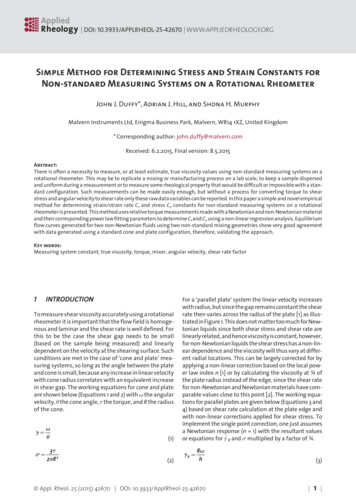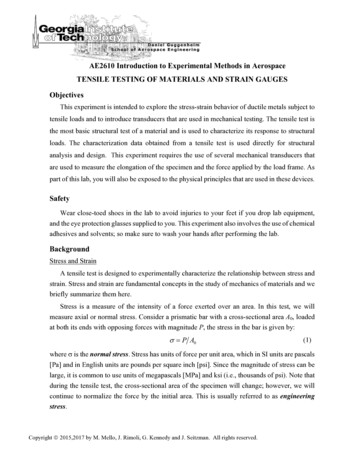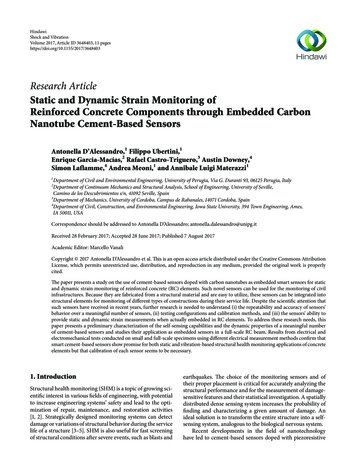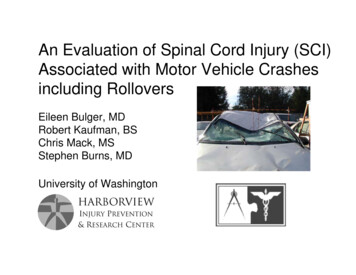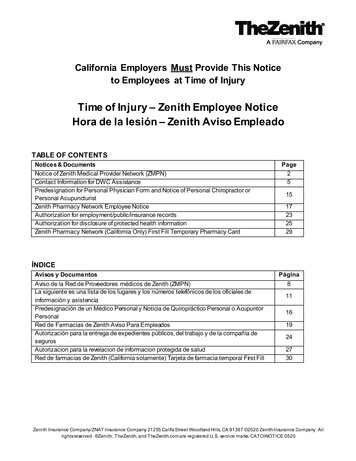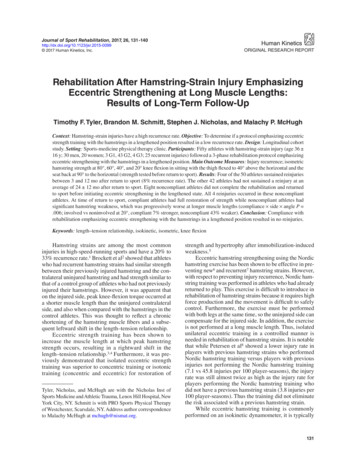
Transcription
Journal of Sport Rehabilitation, 2017, 26, 99 2017 Human Kinetics, Inc.ORIGINAL RESEARCH REPORTRehabilitation After Hamstring-Strain Injury EmphasizingEccentric Strengthening at Long Muscle Lengths:Results of Long-Term Follow-UpTimothy F. Tyler, Brandon M. Schmitt, Stephen J. Nicholas, and Malachy P. McHughContext: Hamstring-strain injuries have a high recurrence rate. Objective: To determine if a protocol emphasizing eccentricstrength training with the hamstrings in a lengthened position resulted in a low recurrence rate. Design: Longitudinal cohortstudy. Setting: Sports-medicine physical therapy clinic. Participants: Fifty athletes with hamstring-strain injury (age 36 16 y; 30 men, 20 women; 3 G1, 43 G2, 4 G3; 25 recurrent injuries) followed a 3-phase rehabilitation protocol emphasizingeccentric strengthening with the hamstrings in a lengthened position. Main Outcome Measures: Injury recurrence; isometrichamstring strength at 80 , 60 , 40 , and 20 knee flexion in sitting with the thigh flexed to 40 above the horizontal and theseat back at 90 to the horizontal (strength tested before return to sport). Results: Four of the 50 athletes sustained reinjuriesbetween 3 and 12 mo after return to sport (8% recurrence rate). The other 42 athletes had not sustained a reinjury at anaverage of 24 12 mo after return to sport. Eight noncompliant athletes did not complete the rehabilitation and returnedto sport before initiating eccentric strengthening in the lengthened state. All 4 reinjuries occurred in these noncompliantathletes. At time of return to sport, compliant athletes had full restoration of strength while noncompliant athletes hadsignificant hamstring weakness, which was progressively worse at longer muscle lengths (compliance side angle P .006; involved vs noninvolved at 20 , compliant 7% stronger, noncompliant 43% weaker). Conclusion: Compliance withrehabilitation emphasizing eccentric strengthening with the hamstrings in a lengthened position resulted in no reinjuries.Keywords: length–tension relationship, isokinetic, isometric, knee flexionHamstring strains are among the most commoninjuries in high-speed-running sports and have a 20% to33% recurrence rate.1 Brockett et al2 showed that athleteswho had recurrent hamstring strains had similar strengthbetween their previously injured hamstring and the contralateral uninjured hamstring and had strength similar tothat of a control group of athletes who had not previouslyinjured their hamstrings. However, it was apparent thaton the injured side, peak knee-flexion torque occurred ata shorter muscle length than the uninjured contralateralside, and also when compared with the hamstrings in thecontrol athletes. This was thought to reflect a chronicshortening of the hamstring muscle fibers and a subsequent leftward shift in the length–tension relationship.Eccentric strength training has been shown toincrease the muscle length at which peak hamstringstrength occurs, resulting in a rightward shift in thelength–tension relationship.3,4 Furthermore, it was previously demonstrated that isolated eccentric strengthtraining was superior to concentric training or isotonictraining (concentric and eccentric) for restoration ofTyler, Nicholas, and McHugh are with the Nicholas Inst ofSports Medicine and Athletic Trauma, Lenox Hill Hospital, NewYork City, NY. Schmitt is with PRO Sports Physical Therapyof Westchester, Scarsdale, NY. Address author correspondenceto Malachy McHugh at mchugh@nismat.org.strength and hypertrophy after immobilization-inducedweakness.5Eccentric hamstring strengthening using the Nordichamstring exercise has been shown to be effective in preventing new6 and recurrent7 hamstring strains. However,with respect to preventing injury recurrence, Nordic hamstring training was performed in athletes who had alreadyreturned to play. This exercise is difficult to introduce inrehabilitation of hamstring strains because it requires highforce production and the movement is difficult to safelycontrol. Furthermore, the exercise must be performedwith both legs at the same time, so the uninjured side cancompensate for the injured side. In addition, the exerciseis not performed at a long muscle length. Thus, isolatedunilateral eccentric training in a controlled manner isneeded in rehabilitation of hamstring strains. It is notablethat while Petersen et al8 showed a lower injury rate inplayers with previous hamstring strains who performedNordic hamstring training versus players with previousinjuries not performing the Nordic hamstring training(7.1 vs 45.8 injuries per 100 player-seasons), the injuryrate was still almost twice as high as the injury rate forplayers performing the Nordic hamstring training whodid not have a previous hamstring strain (3.8 injuries per100 player-seasons). Thus the training did not eliminatethe risk associated with a previous hamstring strain.While eccentric hamstring training is commonlyperformed on an isokinetic dynamometer, it is typically131
Downloaded by Ebsco Publishing aellsworth@ebsco.com on 04/18/17, Volume 26, Article Number 2132 Tyler et alperformed in the seated position with the range of motionfrom approximately 90 knee flexion (short musclelength) to full extension (longer muscle length). However, this position does not place the hamstring near itsmaximum length, and there is minimal stretch on themuscles at full extension. Considering that hamstringstrains often occur in positions of significant stretch,sprinting is a common mechanism for hamstring strains,and the hamstrings work eccentrically at a high intensityin a stretched position while sprinting; during rehabilitation it is important to provide eccentric strengtheningwith the hamstrings in a maximally stretched position atthe knee and the hip simultaneously. This is commonlyreferred to as the lengthened state in rehabilitation.9 Thiscan be achieved on an isokinetic dynamometer by havingathletes seated with the trunk upright or slightly flexedforward (eg, flexed 80–90 relative to horizontal) and thethigh flexed toward the chest (eg, flexed 20–40 relative tothe horizontal).10 In this position there is sufficient stretchon the hamstring muscles such that most individuals areunable to reach full knee extension with passive stretchdue to passive muscle tension.The purposes of this study were twofold: to examineif a progressive eccentric strengthening program duringhamstring-strain rehabilitation restored isometric kneeflexion strength relative to the contralateral side andrestored the angle–torque relationship relative to the contralateral side or shifted it to a longer functional musclelength (rightward shift in the length–tension relationship)and to document the reinjury rate after return to sport.We hypothesized that athletes who completed the rehabilitation program would demonstrate a rightward shiftin their angle–torque relationship and have a low rate ofinjury recurrence.Materials and MethodsStudy ParticipantsThe study group comprised 50 athletes (30 men, 20women) diagnosed with a unilateral hamstring strain thatoccurred during sports performance or recreational exercise (age 36 16 y). Subjects were included if they had amechanism of injury consistent with an acute hamstringstrain, tenderness to palpation over 1 of the hamstringmuscles, pain with resisted prone knee flexion, pain withpassive tension testing using a passive straight-leg-raisetest, and any loss of function of daily or sport activity.Exclusion criteria included other lower-extremity injuriesproducing hamstring pain, complete muscle disruption,avulsion injuries, clinical findings suggesting inguinalor femoral hernia, radiculopathy, history of malignantdisease, incomplete healing and rehabilitation of pelvisor lower-extremity fractures, coexisting pelvis or lowerextremity fractures, clinical findings showing nerveentrapment, sacroiliac dysfunction, or any other impairment limiting participation in the rehabilitation program.All athletes were initially seen at a sports-medicine clinicregardless of the time since the injury had occurred.Twenty-five subjects had had a previous hamstring strainmore than 3 months earlier.Injuries were classified as grade 1, 2, or 3. A grade 1strain was defined as pain with minimal loss of strengthand minimal restriction of motion, a grade 2 strain wasdefined as tissue damage that compromises the strength ofthe muscle but does not include complete loss of strengthand function, and a grade 3 strain was defined as completedisruption of the muscle–tendon unit and complete lossof function of the muscle. Palpation was used to classifyinjury location longitudinally as proximal, midsubstance,or distal and mediolaterally as lateral, central, or medial.Activities at the time of injury and injury mechanismswere documented. Level of play was categorized as competitive or recreational. Competitive sport was defined asa sport in which the participants had regular practice ortraining sessions in addition to games, while recreationalsports were defined as any sport or physical activity without regular practices or training sessions. Competitivesport included high school, college, professional, andclub-level sports. This differentiation was made becauseathletes involved in competitive sports may be at greaterrisk of reinjury due to their greater exposure.Rehabilitation ProtocolAll athletes followed the same rehabilitation protocol (seethe Appendix for details) consisting of 3 clearly definedphases, with progression to the next phase being dependent on being pain free with all components of the previous phase. In general the goal of phase 1 was to protect thehealing tissue, prevent motion loss, and minimize atrophyand strength loss. The goals of phase 2 were to restorepain-free maximal hamstring contractions throughout therange of motion and improve neuromuscular control ofthe trunk and pelvis. The goal of phase 3 was to increasehamstring strength at long muscle lengths and return theathlete to sport with minimal risk of reinjury.With respect to hamstring strength training, phase 1consisted of pain-free submaximal isometric strengthening at multiple angles progressing from short to intermediate muscle lengths in the seated position. In phase 2isokinetic eccentric contractions were performed in theseated position at 0.35 rad/s (20 /s), progressing fromsubmaximal to maximal contractions based on athletes’tolerance during contraction. In phase 3 isokineticeccentric contractions were performed in a lengthenedstate with the subjects sitting with the test thigh flexed40 above the horizontal and the seat back at 90 to thehorizontal (Figure 1). Eccentric contractions were performed from 90 to 20 knee flexion at 0.35 rad/s (20 /s).Athletes were progressed from submaximal to maximalcontractions.Additional isotonic hamstring- and trunk-strengthening exercises were also prescribed in phases 2 and 3.Assisted Nordic hamstring exercise was introduced inphase 2, as this works the hamstrings in short to intermediate length. In phase 3, plyometric and sport-specificdrills were introduced in preparation for return to play. AJSR Vol. 26, No. 2, 2017
Downloaded by Ebsco Publishing aellsworth@ebsco.com on 04/18/17, Volume 26, Article Number 2Rehabilitation After Hamstring Strain 133contractions shifted the length–tension relationship to theright and if this resulted in a low rate of injury recurrence,the results of the isometric testing were not used to determine readiness for return to play. We did not perform thelengthened-state test earlier in the rehabilitation process aswe felt that this could potentially create a risk for reinjury.Reliability for the isometric strength-testing protocolwas assessed in 10 healthy volunteers who performed theprotocol on 2 separate occasions at least 1 week apart.Measurements were made bilaterally, and the standarderror of the measurement (SEM) was computed. Thesedata were used to determine the sample size required todemonstrate a clinically relevant change in the angle–torque relationship. This measurement technique haspreviously been shown to be effective at demonstratingchanges in the length–tension relationship due to passive stretching10,11 and in response to exercise-inducedmuscle damage.10Follow-Up ProcedureFigure 1 — The setup for isokinetic eccentric hamstringexercise in the lengthened state and isometric knee-flexionstrength testing is shown. The trunk was flexed to 90 to thehorizontal and the thigh was flexed to 40 above the horizontalplane. Eccentric exercise was performed from 90 to 20 kneeflexion at 0.35 rad/s (20 /s) (a knee flexion of approximately55 shown in the picture).home exercise program was given and modified throughout the course of rehabilitation (see Appendix). Criteriafor return to play were being pain free with maximaleccentric contractions in the lengthened state and beingpain free with sport-specific functional tasks and sprinting. All subjects gave written informed consent, and theprotocol was approved by an institutional review board.Angle–Torque (Length–Tension)RelationshipBefore discharge from physical therapy all athletesperformed an isometric knee-flexion-strength test in thesame seated position in which lengthened-state eccentriccontractions were performed. Athletes who chose not tofinish the rehabilitation program or had to stop for otherreasons were asked to return for isometric strength testing.Strength was assessed bilaterally at 80 , 60 , 40 , and 20 knee flexion to provide a measure of the length–tensionrelationship. For most subjects in this test setup the kneeflexion angle was 40 when the dynamometer arm washorizontal (parallel to the floor). The limb mass and torquedue to passive hamstring tension were subtracted fromtorque values at each angle to provide a measure of hamstring contractile torque production only. Two maximalcontractions were performed at each angle, progressingfrom short to long muscle lengths. Since the purpose ofthe study was to determine if lengthened-state eccentricAthletes were followed for documentation of reinjuryafter return to play by the study authors who providedmedical coverage for their respective teams. If the athletewas not involved with a team covered by an author, heor she was contacted by phone to assess current sportparticipation and determine if a reinjury had occurred.Athletes were contacted at 3 and 6 months after returnto sport and every 6 months thereafter. At the time oflong-term follow-up (24 12 mo) only 2 athletes werenot still regular participants in their sport (they had failedto make their respective college and professional teams).Statistical AnalysesDifferences in knee-flexion torque between the involvedand noninvolved sides across the different musclelengths tested were assessed using repeated-measuresanalysis of variance (ANOVA). Since some athletesreturned to play before completion of the rehabilitationprotocol (see Results section), compliance was addedas a between-subjects factor in the ANOVA (compliantvs noncompliant). Effects of previous hamstring injury,level of sport, and location of current injury on strengthbefore return to sport were assessed using mixed-modelANOVA (involved vs uninvolved leg and joint angle werewithin-subject factors, and previous injury, level of sport,and location of injury were between-subjects factors).Since the goal of the lengthened-state eccentricstrengthening was to increase strength at longer musclelengths, the sample-size estimate for the study was basedon the variance in the difference in torque between theright and left legs of the control group. Based on thesedata we estimated that with a sample of 50 athletes aninvolved-to-noninvolved difference of 3.6 Nm for absolutetorque could be detected at an alpha level of .05 (adjustedfor multiple comparisons) and a beta level of .2 (80%power). Reinjury rates were compared between compliant and noncompliant athletes using Fisher exact tests.JSR Vol. 26, No. 2, 2017
134 Tyler et alResults 1.4 for compliant athletes and 1.4 0.8 for noncompliant athletes (P .07).Downloaded by Ebsco Publishing aellsworth@ebsco.com on 04/18/17, Volume 26, Article Number 2Details of Hamstring StrainsThere were 3 grade 1 strains, 43 grade 2 strains, and4 grade 3 strains. There were 27 proximal injuries (13lateral, 8 central, 6 medial), 14 midsubstance injuries(3 lateral, 8 central, 3 medial), and 9 distal injuries (6lateral, 3 medial). The mechanism of injury was sprinting in 38 cases (8 American football, 3 Gaelic football,2 soccer, 4 softball, 6 track, 7 recreational running, 3 hillrunning, 2 lacrosse, 2 field hockey, 1 basketball). The 12nonsprinting injuries occurred in stretching (3), karate(2), plyometrics (3), squash, waterskiing, skiing, weighttraining. At the time of injury 32 of the athletes wereinvolved in recreational sports or exercise and 18 wereinvolved in competitive sports (2 professional, 2 college,10 high school, 4 club).Compliance With RehabilitationOf the 50 athletes in the study, 8 chose to return to playbefore completing all 3 phases of the rehabilitation protocol (noncompliant athletes). Three noncompliant athleteswere recreational runners who chose to return to runningbefore completion of rehabilitation as they felt theywere at low risk of reinjury (1 sustained a reinjury). Onefitness-class participant returned before completion as herpriority was to maintain her fitness routine. A recreationalsoftball player and a high school football player returnedto play understanding the increased risk but wanting tocomplete their competitive seasons (both sustained reinjuries). A Gaelic football player had to return to collegebefore completing the rehabilitation and did not havethe facilities to continue while at college. He sustained areinjury when returning to Gaelic football at the end ofthe semester, after which he chose not to return to schooluntil completing the rehabilitation. A high school soccerplayer went off to college before completing rehabilitation and chose not to pursue rehabilitation there.Since 1 noncompliant athlete returned to rehabilitation after sustaining a reinjury and completed the fullprotocol, results are reported for 8 noncompliant athletes and 43 compliant athletes. Isometric strength testswere performed before return to play on all 8 athleteswho failed to complete the full rehabilitation protocol.Three of these 8 athletes had completed phase 1 (malehigh school football player, female high school soccerplayer, female recreational runner) but had not startedisokinetic eccentric strengthening. Five athletes hadcompleted phase 2 but had not started lengthened-stateeccentric strengthening (male softball player, male andfemale recreational runner, male Gaelic football player,female fitness-class participant). The average number ofphysical therapy treatments was 11 7 for the 8 noncompliant athletes and 17 7 for the compliant athletes (P .09). Time from initial treatment to discharge was 11 10 weeks for the compliant athletes and 11 8 for thenoncompliant athletes (P .98). Visits per week were 2.4Hamstring Strength and the Length–Tension Relationship (Angle–Torque)For all athletes, hamstring strength was not differentbetween the involved and noninvolved sides at each angleat the time of return to sport (side effect P .35). Peaktorque occurred at intermediate lengths (angle effectP .001) in both the involved and noninvolved sides(side by angle P .41). However, when strength resultswere compared between compliant and noncompliantathletes, clear differences were apparent. Noncompliant athletes had marked weakness on the involved sidethat was more apparent at longer muscle lengths, whilecompliant athletes had no apparent hamstring weakness(compliance side angle P .006; Figure 2). Strengthdeficit for the noncompliant athletes averaged –29.2% 15.1% across all angles compared with 1% 20% forcompl
Schmitt is with PRO Sports Physical Therapy of Westchester, Scarsdale, NY. Address author correspondence to Malachy McHugh at mchugh@nismat.org. Rehabilitation After Hamstring-Strain Injury Emphasizing Eccentric Strengtheni

